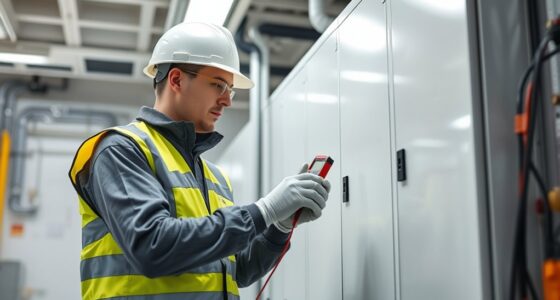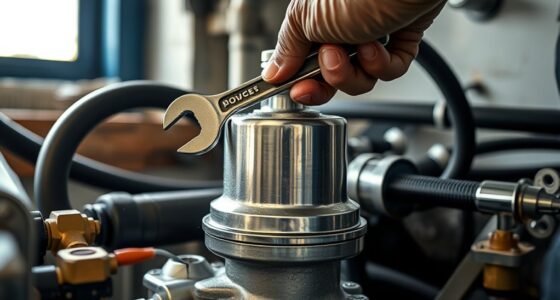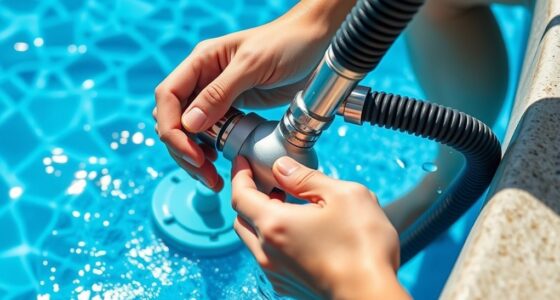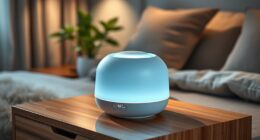To stay safe when using your automatic pool cleaner, always follow the manufacturer’s instructions carefully and keep the area clear of obstructions. Never operate the cleaner when people are swimming, and guarantee electrical connections are dry, grounded, and used with GFCI outlets. Supervise children and pets during operation, and disconnect power before removal or maintenance. Proper setup and quick emergency disconnection are essential. Continuing with these tips will help you ensure safe use and prolong your cleaner’s lifespan.
Key Takeaways
- Read and follow the manufacturer’s instructions carefully before operating the cleaner.
- Ensure electrical connections are dry, grounded, and use GFCI outlets to prevent shocks.
- Never operate the cleaner when people are in the pool to avoid injuries.
- Regularly inspect and maintain the cleaner, including checking for damage and cleaning filters.
- Turn off power and disconnect the device before removing or servicing to ensure safety.
Read the Manufacturer’s Instructions Carefully

Before using your automatic pool cleaner, it’s crucial to read the manufacturer’s instructions thoroughly. The user manual provides essential information on proper operation, safety precautions, and maintenance tips. Manufacturer guidelines are designed to ensure you use the cleaner effectively and avoid potential hazards. Take the time to understand the recommended setup process, electrical connections, and the correct way to position the device in your pool. Ignoring these instructions can lead to damage, inefficient cleaning, or safety risks. Always keep the user manual accessible for future reference, especially if you need to troubleshoot issues or perform maintenance. Following the manufacturer’s recommendations helps you maximize your cleaner’s lifespan while keeping your pool safe for everyone. Proper adherence to safety guidelines can prevent accidents and ensure optimal performance. Additionally, understanding electrical safety procedures is vital to prevent shocks or other hazards during operation. Being aware of preventive maintenance practices can further prolong the lifespan of your automatic pool cleaner.
Regularly Inspect and Maintain Your Cleaner

Regularly inspecting and maintaining your automatic pool cleaner is vital to keep it functioning efficiently and safely. Follow a consistent cleaning schedule to prevent debris buildup that can hinder performance. Check the brushes, hoses, and wheels for signs of wear or damage, replacing parts as needed. Regular filter maintenance is essential; clean or replace filters according to the manufacturer’s recommendations to guarantee maximum suction and filtration. Keep an eye out for clogs or blockages that could cause the cleaner to malfunction. Proper maintenance not only extends your cleaner’s lifespan but also reduces the risk of accidents caused by malfunctioning equipment. Make it a habit to inspect your cleaner weekly, especially after heavy pool use, to keep it running smoothly and safely. Additionally, understanding projector contrast ratios can help you optimize your viewing environment for better clarity and image quality. Incorporating routine inspections and checking for wear or damage to parts can further prevent unexpected breakdowns and ensure optimal performance. Regularly reviewing manufacturer guidelines ensures you follow best practices for ongoing maintenance and safety. For example, paying attention to automatic pool cleaner specifications can help you choose the right maintenance routine tailored to your model.
Keep the Pool Area Clear of Obstructions

Keeping the area around your pool free of obstructions is key to ensuring your automatic cleaner operates smoothly and safely. Clear the deck of toys, furniture, and other objects that could interfere with the cleaner’s movement. This not only prevents damage but also reduces trip hazards. Pay special attention to pool cover safety—ensure covers are securely stored when not in use, preventing accidental falls or entanglements. Additionally, follow proper chemical storage guidelines, keeping chemicals away from the cleaning area to avoid spills or reactions that could harm your equipment or create safety risks. Proper storage of chemicals can also prevent chemical reactions, which might damage your pool equipment or pose health hazards. Maintaining a tidy pool deck promotes safe operation, protects your investment, and keeps everyone around the pool safe from accidents caused by clutter or improper chemical handling. Regularly inspecting your equipment and adhering to safety standards, such as fire safety regulations, further enhances pool area safety. Incorporating equipment maintenance routines helps identify potential issues before they become hazards. Moreover, understanding pool safety protocols can significantly reduce the risk of accidents and improve overall safety. Additionally, keeping a first aid kit nearby is recommended in case of minor injuries during pool maintenance or cleaning.
Never Operate the Cleaner When People Are in the Pool
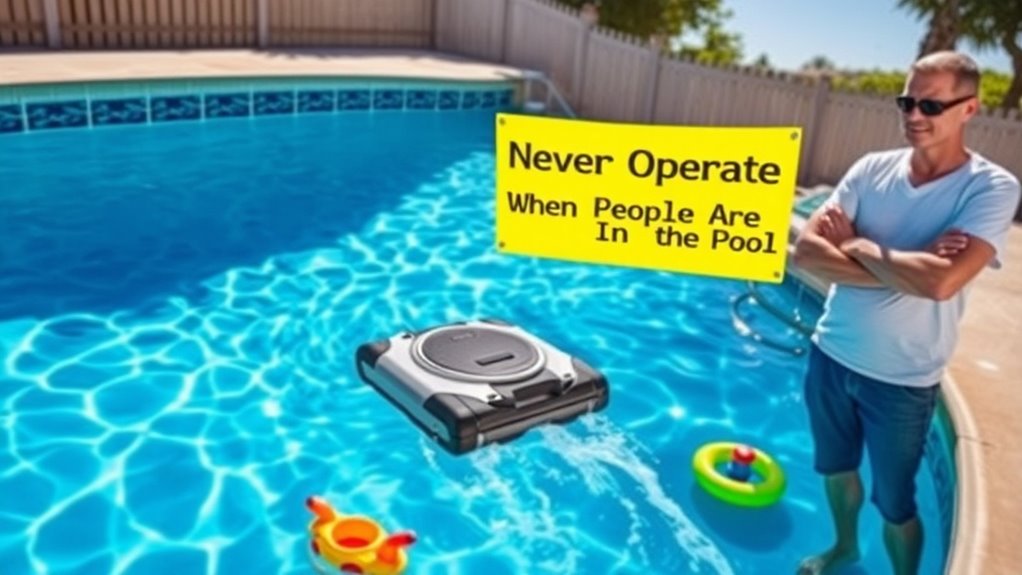
Have you ever thought about what could happen if you run your automatic pool cleaner while people are swimming? It poses serious risks to pool safety. For example:
- The cleaner might collide with swimmers, causing injuries.
- Disrupted water chemistry could harm skin and eyes.
- Swimmers may get tangled in the device or its cords.
- The cleaner could stir debris, reducing water clarity and safety.
- Using vintage decor elements in pool surroundings can sometimes obstruct visibility or create tripping hazards if not properly maintained. Additionally, ensuring proper automatic cleaner operation protocols enhances overall safety.
Always turn off the cleaner when the pool is in use. Running it during swimming sessions can lead to accidents or equipment damage. Ensuring no one is in the water is crucial for safe operation. Remember, prioritizing water chemistry and pool safety helps prevent hazards and keeps your pool a safe, enjoyable environment for everyone.
Use Proper Power Sources and Avoid Water Contact With Electrical Components
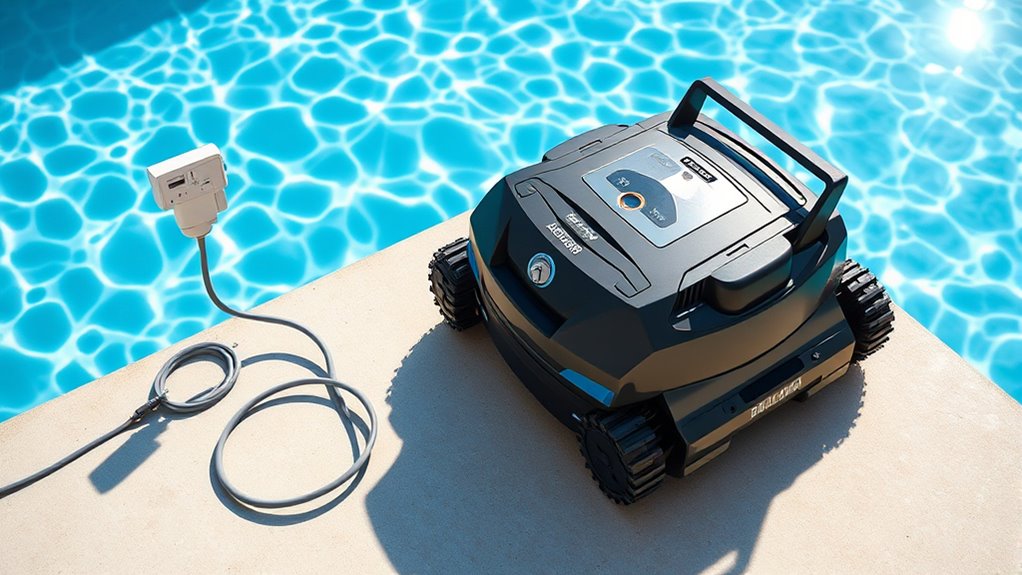
Always inspect your power cord for damage before use, and keep it properly grounded. Make sure electrical connections stay dry and away from water to prevent shocks. Using GFCI outlets adds an extra layer of safety by shutting off power if a leak or fault occurs. Incorporating security measures such as circuit interrupters can further enhance safety during pool cleaning. Regularly check the electrical safety features of your equipment to ensure optimal protection. Additionally, staying informed about AI in Education advancements can help you understand the importance of safe and secure technology use. Understanding tuning principles can also help you better maintain and monitor your equipment’s safety features. Familiarity with Retirement Planning concepts can remind you to periodically review and update your safety measures to adapt to new risks and improvements.
Check Power Cord Safety
To prevent electrical hazards, it’s important to use the correct power sources for your automatic pool cleaner and keep electrical components away from water. Start by inspecting the power cord for damage or fraying. Ensure the cord length considers your pool layout to avoid stretching or tangling. Always verify that the power outlet has proper electrical grounding to prevent shocks. When plugging in, keep the cord away from water, pool sides, and wet surfaces. Additionally, follow these safety tips:
- Use a GFCI outlet for extra protection.
- Avoid using extension cords unless specifically rated for outdoor use.
- Regularly check the cord for signs of wear.
- Never handle the cord with wet hands.
Keep Electrical Dry
Keeping electrical components dry is key to safe automatic pool cleaner use. Water and electricity don’t mix, so ensuring proper moisture protection is essential. Always plug your cleaner into a properly grounded power source and avoid handling electrical parts with wet hands. Use outdoor-rated extension cords and keep cords away from water to prevent electrical safety hazards. Inspect power cords regularly for damage, and never submerge or expose electrical connections to water. Keep the power supply and connections elevated and away from the pool edge. By maintaining dry electrical components, you’ll reduce the risk of electric shock or equipment damage. Proper moisture protection is critical in preventing electrical hazards and ensuring longevity of your equipment. Regularly checking for electrical safety hazards and addressing any issues promptly can further enhance safety. Additionally, using ground fault circuit interrupters (GFCIs) can provide an extra layer of protection against electrical faults. Prioritize moisture protection at all times to enjoy safe, effective pool cleaning without unnecessary hazards.
Use GFCI Outlets
Using GFCI outlets is essential for safe automatic pool cleaner operation, especially when dealing with water and electricity. GFCI protection detects ground faults and disconnects power instantly, reducing the risk of electric shock. To guarantee electrical safety, follow these tips:
- Always plug your pool cleaner into a GFCI outlet before use.
- Regularly test GFCI outlets to confirm they’re functioning correctly.
- Avoid using extension cords; instead, connect directly to a grounded GFCI outlet.
- Keep electrical connections dry and away from water splashes or puddles.
Remove Debris and Obstructions Before Starting the Cleaner
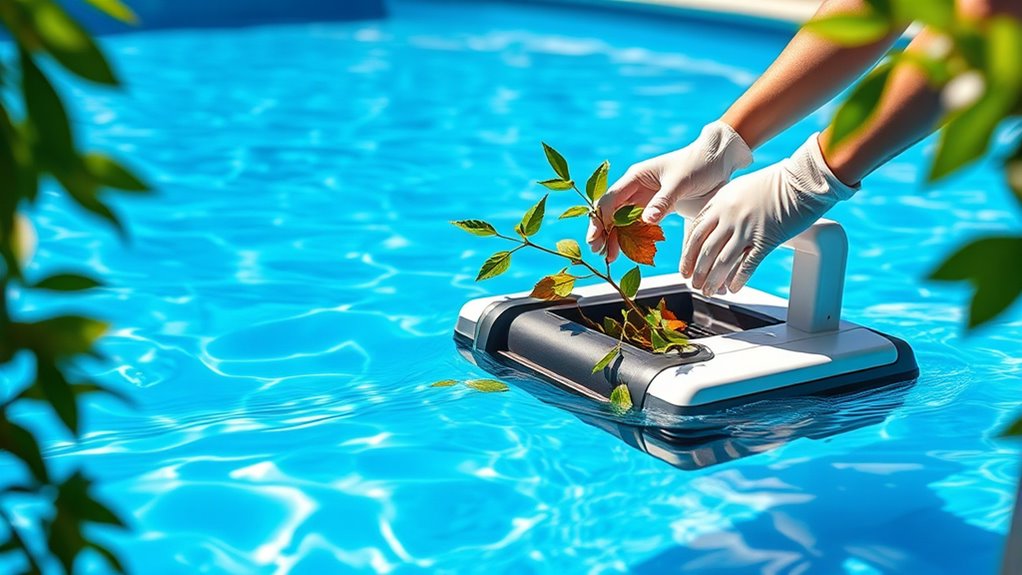
Before starting your automatic pool cleaner, make sure to remove any debris and obstructions from the pool surface and floor. Clearing large leaves, twigs, and toys helps guarantee proper pool water circulation and prevents the cleaner from clogging or getting stuck. Use debris filtering techniques like skimming the surface and sweeping the bottom to maintain a clean environment. Removing obstructions also reduces strain on the cleaner’s brushes and filters, making it more efficient. Check for any objects that could interfere with movement or damage the equipment. Proper preparation minimizes the risk of breakdowns and prolongs your cleaner’s lifespan. Being aware of common zombie-inspired designs can help you identify potential hazards or obstacles for certain themed costumes. Taking these steps ensures your cleaner operates smoothly, keeps your pool tidy, and promotes safe, effective cleaning every time.
Supervise Children and Pets Around the Pool During Operation
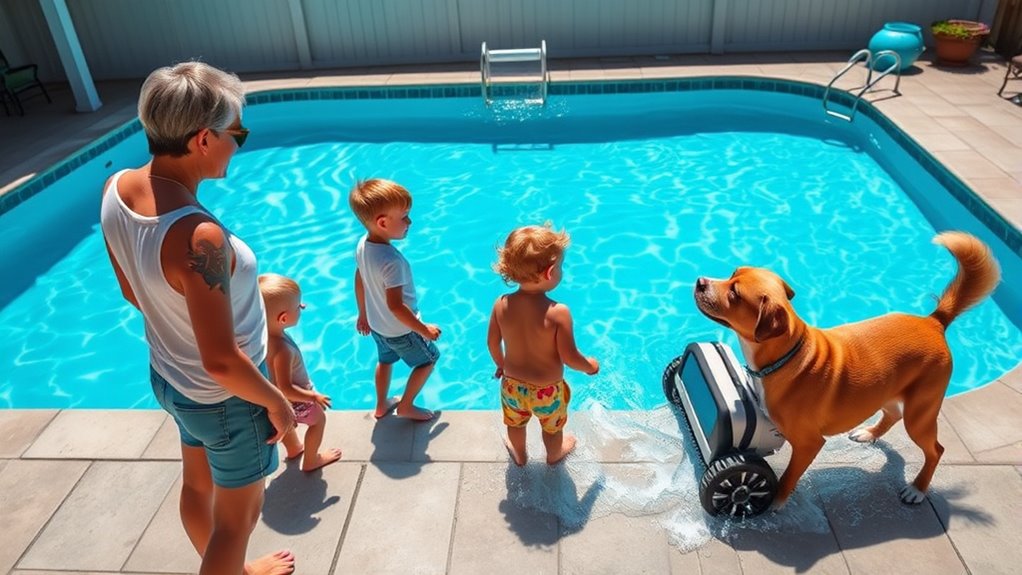
Always keep a close eye on children and pets when the pool cleaner is running. You should maintain constant visual monitoring to quickly respond to any unsafe situations. Establish clear safety boundaries to prevent accidental entry into the pool area during operation. Using supervision techniques can further reduce the risk of accidents around the pool. Additionally, being aware of interior design considerations can help create safer pool areas by minimizing hazards.
Constant Visual Monitoring
Since automatic pool cleaners operate quietly and may go unnoticed, monitoring children and pets closely whenever the cleaner is running is vital. Regular visual inspection ensures you catch any potential hazards early. Stay alert to maintain operator awareness and prevent accidents. To effectively monitor:
- Keep a constant watch on the pool area during cleaner operation.
- Quickly identify if children or pets approach the pool.
- Use clear sightlines to observe the entire pool surface.
- Halt the cleaner immediately if you notice any unsafe behavior or enter the water.
Establish Safety Boundaries
To prevent accidents while the automatic pool cleaner is running, actively supervise children and pets around the pool area. Establish clear safety boundaries by keeping kids and animals away from the pool during cleaning, reducing the risk of injuries or drowning. Ascertain that pool chemical safety is maintained by storing chemicals securely and avoiding contact during operation. Implement outdoor cleaning precautions by setting up physical barriers or alarms to alert you if someone enters the pool zone. Regularly check that the automatic cleaner is functioning properly and that no one is in its path. Staying vigilant helps prevent mishaps, and reinforcing these boundaries keeps everyone safe while maintaining a clean, healthy pool environment.
Store the Cleaner Safely When Not in Use
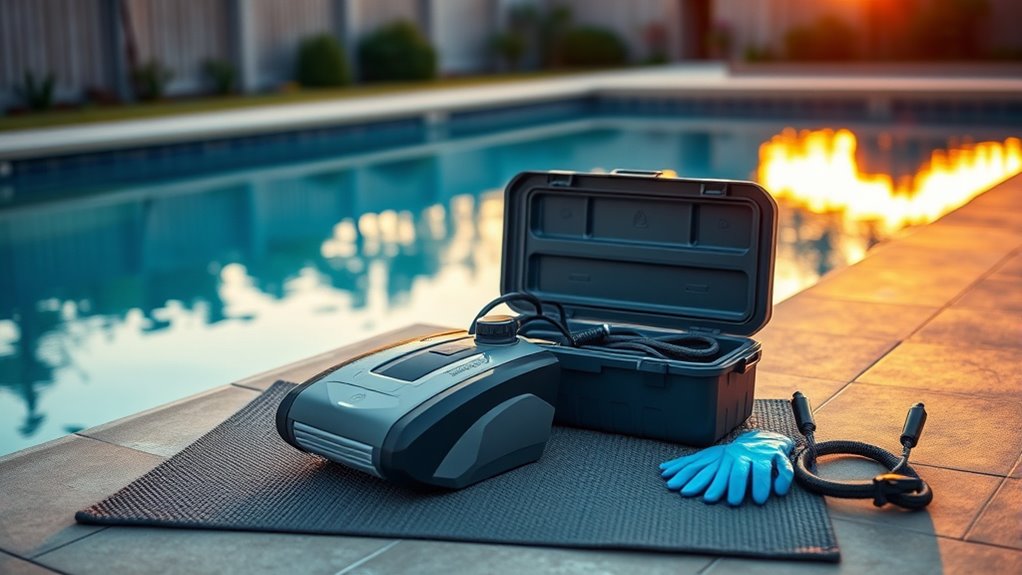
Properly storing your automatic pool cleaner when it’s not in use helps guarantee it stays in good condition and ready for next time. Good storage safety and cleaner organization prevent damage and ensure safe handling. To keep your cleaner in top shape, follow these steps:
Proper storage keeps your pool cleaner in top condition and ready for use.
- Rinse the cleaner thoroughly to remove debris and chemicals.
- Dry it completely to prevent mold and corrosion.
- Store it in a cool, dry place away from direct sunlight.
- Keep the power cord neatly coiled to avoid damage or tripping hazards.
Ensure Proper Fit and Setup of the Cleaner

Ensuring your automatic pool cleaner is properly fitted and set up is essential for ideal performance and safety. Check that the cleaner has a proper fit by confirming all hoses, brushes, and components are securely attached and aligned correctly. An improper fit can lead to inefficient cleaning or damage to the equipment. Take time to follow the manufacturer’s instructions for setup calibration, ensuring the cleaner’s sensors and navigation system are accurately configured. Proper setup helps prevent malfunctions and reduces the risk of accidents during operation. Regularly inspect the connections and calibration as recommended, especially after cleaning or maintenance. When everything is correctly fitted and calibrated, your cleaner will operate smoothly, effectively, and safely, giving you peace of mind while enjoying your pool.
Know How to Turn Off and Disengage the Cleaner in an Emergency

In an emergency, you need to act quickly to stop the cleaner. Locate the power switch immediately and disconnect the power source securely before removing the cleaner from the pool. Knowing these steps can help prevent accidents and ensure everyone’s safety.
Locate Power Switch Quickly
Knowing how to quickly locate the power switch is essential in an emergency. Your pool area should have the power switch in a visible, accessible spot for quick access. To guarantee you can shut off the cleaner swiftly, consider these tips:
- Identify the power switch location before use.
- Keep the switch free of obstructions.
- Install clear signage if necessary.
- Practice locating it during routine checks.
Having the power switch in an easy-to-reach spot allows you to act fast if needed. Remember, quick access can prevent accidents and damage. Familiarize yourself with its position, so you’re prepared in urgent situations. Always prioritize safety by knowing exactly where and how to turn off the automatic pool cleaner promptly.
Disconnect Power Source Safely
Disengaging the power source promptly is essential during emergencies to prevent accidents or damage. First, turn off the main switch or unplug the cleaner from the electrical outlet, ensuring electrical grounding is maintained to avoid shock risks. If your cleaner uses a battery, follow proper battery safety procedures: disconnect the battery safely, avoiding contact with water or conductive materials. Always handle batteries carefully to prevent sparks or short circuits. Confirm the power is completely off before attempting any further inspection or maintenance. Remember, electrical grounding helps protect you from electrical shocks if a malfunction occurs. Never hesitate to disconnect power immediately if you notice unusual sounds, sparks, or water contact with the electrical parts. Safety comes first—quickly and correctly disconnecting power can prevent serious harm.
Remove Cleaner From Pool
When an emergency arises requiring the removal of your automatic pool cleaner, acting quickly and confidently is essential. To do so safely, follow these steps:
- Turn off the power supply to prevent accidents.
- Engage your cleaner’s disengagement or reset features, if available.
- Gently lift the cleaner from the water, avoiding abrupt pulls.
- Inspect for any damage or entanglements that could affect your maintenance routines and cleaning schedules.
Removing the cleaner carefully ensures safety and preserves its functionality. Regularly reviewing your maintenance routines and cleaning schedules helps identify issues early, minimizing emergencies. Always follow the manufacturer’s instructions for disengagement and removal, and never rush the process. Staying prepared and cautious keeps everyone safe and prolongs your cleaner’s lifespan.
Frequently Asked Questions
How Often Should I Replace Parts of My Automatic Pool Cleaner?
You should replace parts of your automatic pool cleaner as recommended by the manufacturer, typically every 1-2 years for belts and brushes. Regular maintenance helps guarantee peak performance, which ties into pool chemical maintenance and pool cover safety. Keep an eye on wear and tear, and inspect parts frequently. Replacing worn parts prevents damage, maintains safety, and keeps your pool clean and safe, especially when managing pool chemicals and ensuring the pool cover stays secure.
Can I Use My Cleaner in Saltwater Pools?
Can you use your cleaner in saltwater pools? Absolutely, but check for saltwater compatibility first. Confirm your automatic pool cleaner is designed to resist cleaner corrosion caused by salt. Look for models labeled as saltwater-compatible, and regularly rinse your cleaner with fresh water to prevent salt buildup. Doing so extends its lifespan and keeps your cleaner running smoothly, ensuring you enjoy a spotless pool without worrying about damage or corrosion.
What Should I Do if the Cleaner Gets Stuck Frequently?
If your automatic pool cleaner gets stuck frequently, first check for debris that might be blocking its path. Manually remove the cleaner and clear any debris in the pool or on the cleaner itself. Confirm the cleaner’s wheels and brushes are clean and functioning properly. Regularly perform debris clearing to prevent future issues, and inspect the pool’s surfaces for rough spots or obstacles that could cause it to get stuck.
Are There Specific Safety Gear Recommendations During Maintenance?
They say, “Better safe than sorry,” and that holds true during pool maintenance. You should wear protective gloves to guard your skin and safety goggles to protect your eyes from debris or splashes. These safety gears are essential, especially when dealing with chemicals or cleaning parts. Always prioritize your safety first, so you can enjoy your pool worry-free, knowing you’re well-protected during maintenance.
How Can I Troubleshoot if the Cleaner Isn’T Moving Properly?
If your automatic pool cleaner isn’t moving properly, start by inspecting for pool debris that could be blocking the brushes or wheels. Check for power issues, ensuring the cord is plugged in securely and the power source is functioning. Sometimes, tangled cords or debris buildup can prevent movement. Clearing debris, untangling cords, and verifying power connections often resolve these issues and get your cleaner moving smoothly again.
Conclusion
Did you know that according to the CDC, drowning is the leading cause of injury-related death among children aged 1-4? By following these safety tips, you can greatly reduce risks and keep everyone safe around your pool. Always read instructions, supervise kids, and store your cleaner properly. Staying vigilant not only protects your loved ones but also ensures your pool stays clean and enjoyable all season long. Safety should always come first!


